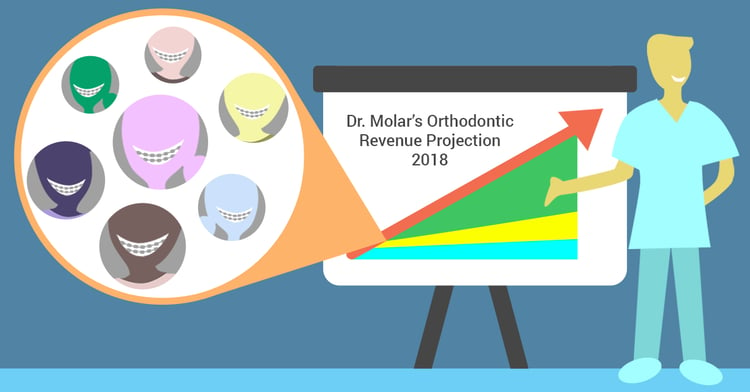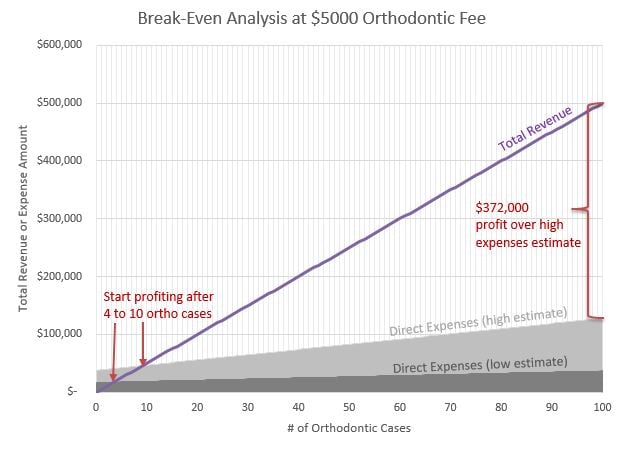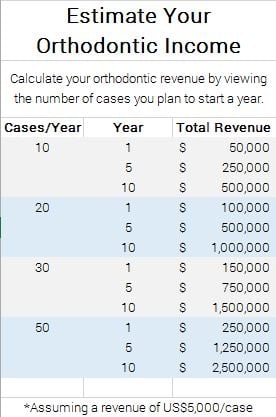
As a general dentist, you have the flexibility to evolve your services to maximize your profits (and happiness). For those researching if orthodontics may be a good business move for you, this post will help you understand how it would affect your bottom line.
Our break-even analysis shows that you are likely to start profiting after treating just 4 to 10 orthodontic patients. Even if you invest in a larger set up, you can still easily profit within your first year of learning and treating orthodontics.

As you can see, even with a higher investment, you can start seeing profitability after your 10th case. You may find the equation we used below. You are welcome to tailor the equation with your specific variables to specifically understand how quickly you will make a profit over your expenses.
Break-Even Equation: Total Revenue = Total Expenses
R*N = V*N + F
N = # of cases
R = revenue per case (assumed at $5,000 for this analysis)
V = variable cost per case ($200-$900 for this analysis)
F = fixed orthodontic costs ($17,000-$38,000 for this analysis)
Our variables used are detailed in the next sections. We used conservative numbers for this analysis and just looked at direct expenses (not time or travel to study or chair time as that is variable etc.)
Your Overall Orthodontic Margin
For simplicity, we are looking at the margin of adding orthodontics as a segment only, and ignored overhead costs that cover your entire business (like rent, utilities, manager salary, etc.). You can calculate it with this equation:
Orthodontic Margin = Revenue – Direct Expenses
Let’s look at these components so you can estimate your orthodontic financial potential.
Your Typical Orthodontic Expenses
Orthodontics is often seen as profitable because there are low expenses. Below is an explanation of the types of costs and revenue that you can expect. We included ranges so you can better estimate your investment, based on your type of practice and goals. Amounts will vary, so please take this as a helpful guide. These estimates relate best with U.S. dental practices and are in US$, but can be adapted to any location.
Fixed Costs – Estimation: $17,000-$38,000
Costs you can expect to incur to start orthodontics
- Equipment –$7,000-$18,000. Luckily you won’t need much equipment, including expensive machines. While having a ceph machine makes record taking convenient, you do not need one (you can send your patient to a lab, and thus a ceph expense isn't included in this figure.) You’ll need some instruments, record taking items, and a band sizing kit. We've also included estimations for higher-volume offices, where you may want to get some extra brackets (helpful if a bracket pops off), extra instruments (to schedule back-to-back patients), and other items for inventory (but this is just for added convenience).
- Education – $10,000-$20,000. This is probably one of the largest expenses you’ll incur. Orthodontics is a “thinking specialty” so you need to learn how to treat patients properly. There are a few reputable programs teaching comprehensive orthodontics to general dentists such as Progressive Orthodontic Seminars and the United States Dental Institute. If you take shorter training programs, your tuition will be less, usually ranging from $3,000-$15,000. However, please note that with shorter, limited programs, you may not have the full knowledge or support to finish orthodontic cases successfully. Comprehensive training tuition is listed in the analysis as this is what's recommended for long term success and profitability.
- Marketing – Little to none. As a general dentist, you probably will get most orthodontic patients from your own patient source. Thus, you’re likely to have almost no marketing expenses (outside of updating your signage or website etc.)
Variable Costs – Estimation: $200-$900 per case (plus chair time)
Costs you can expect to incur per case
- Appliance – $150-$200. Buying appliances per case is usually the best business choice for GPs. You minimize inventory and waste by purchasing your case’s appliances only after your patient agrees to start treatment. This figure reflects the IP Appliance costs for one patient’s customized metal bands, brackets and archwires. Assume around $50 more if choosing ceramic. Alternatives: Some dentists buy in bulk. This may save you some cost per unit but you typically have higher expenses in chair time and inventory/storage. You can also purchase surprisingly cheap brackets from manufacturers in China and Thailand. We highly discourage this as the quality is usually low and would likely affect the results of your cases and increase chair time expenses.
- Extra Materials – $50-$100. Maybe you’ll need some glue, coils, headgear, retainer case, colored elastics, ligature wire, etc.
- Records – $0. Many dentists arrange for their patients to pay for their records. This filters out the less serious patients and helps you to optimize your time. Sometimes insurance covers records (or part of it) as well. If you decide to cover the records, expect a few hundred dollars more of expense.
- Chair time – Variable. Minimizing chair time is key to financial orthodontic success. It’s variable, based on what you calculate your staff's time is worth. Luckily, good orthodontic staff, good brackets, and a good treatment plan, will help you reduce your chair time. You can play around with some numbers. Assuming a 2 year case, you can expect to see your patients every month, (or every 2 months with smarter brackets like the IP Appliance). With 15 minute appointments, and 1 hour initial and final appointments, this may take around 7.5 hours of chair time (or 5 hours if using smarter brackets).
- Mentoring (optional) – $300-$600. If you want extra support, you can pay consultants or mentors to guide you in your case. If you need immediate help, expect a slight premium on express consulting. Usually we see doctors minimize their use of consulting and mentoring once they gain more experience (after around 10 to 40 cases). Or, if you’re lucky, you may have supportive colleagues or orthodontists who are happy to help with a question every once in a while.
Your Typical Orthodontic Revenue
Orthodontic fees can be a great income source. Since rates vary greatly by region, look at the fees of orthodontists and dentists in your town to estimate your potential revenue. This site lists the average rate by state, given by the Journal of Clinical Orthodontics in 2012.
Nationwide, the average fee for U.S. orthodontists providing traditional metal braces to adults was $5,200 in a 2012 study.1 The Journal of Clinical Orthodontics produced a survey that looked into cash orthodontic rates among 10,956 American orthodontists. Their study showed great range by region, varying from $3,000 to $7,500. If you take insurance, you can check reimbursement rates and adjust accordingly. POS tenured instructor, Dr. Joseph Viviano mentions that he's seen rates ranging from $2000 to $5600.
Once you estimate what you will charge, calculate the revenue that you can expect. Below is a simplified revenue chart based on $5,000 per case. Want to start a case a week? You'll gain over a quarter of a million dollars of new revenue in just 1 year!

Orthodontic revenue compared to other dental procedures are usually spread out over a longer period. Please keep this in mind as this may not be ideal for some practices. However, for others, this can be a nice, stable income source.
So, how much more do I have to work for this added income?
Progressive Orthodontic Seminars CEO, Miles McGann, says that most POS dentists spend 2 to 9 hours per case of "doctor time". (If you don't use the POS software or customized brackets, expect a slightly higher estimation.) Most of your time will be diagnosing and planning the treatment well, so the case goes smoothely in treatment. You'll also spend chair time with bonding (unless you indirect bond), mechanics and debonding. Luckily, you won't need to work a lot more since your team should help with the majority of chair time work.
McGann says that you can expect to take around 9 hours per case on your first patients, but will see much greater efficiency after starting 20. After 100 cases, your team will be highly efficient and your chair time should be greatly reduced.
Although you won't make much profit on your first cases, once you and your team become efficient, these numbers show that you may expect to take home $2000 per hour of your time.

1. Mean Fees by Geographic Region. Journal of Clinical Orthodontics. 2011. https://www.bracesinfo.com/how-much-do-braces-cost.html Accessed Nov 2, 2016.
2. What is the average annual return for the S&P 500? Investopedia. http://www.investopedia.com/ask/answers/042415/what-average-annual-return-sp-500.asp Accessed Nov 2, 2016.
Have you analyzed the business of orthodontics differently? Share it with the community in the comments.


